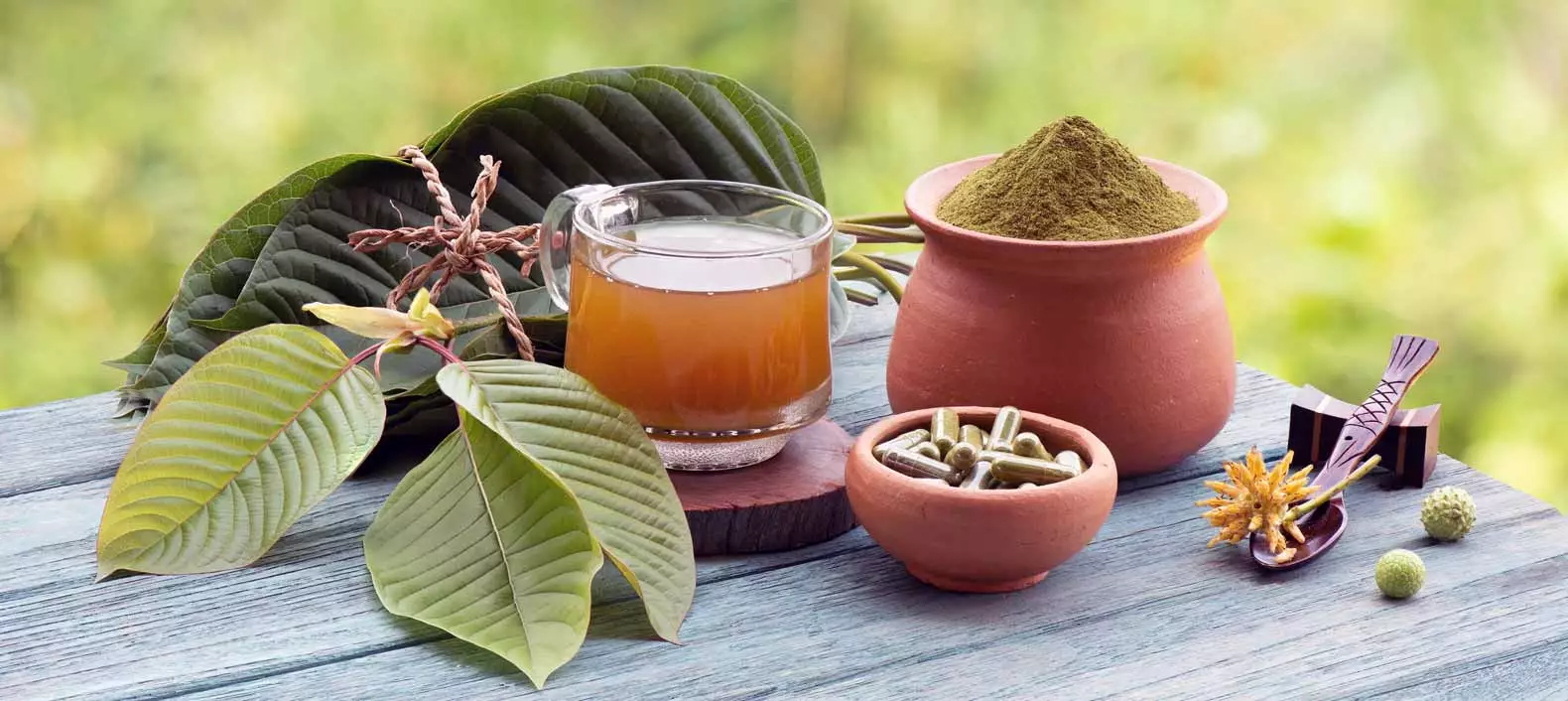
Kratom is a drug that many people have taken to using, but it’s not as well-known as other drugs and tends to be overlooked by many people. Despite this fact, it has a relatively high rate of addiction and, hence, a corresponding need for kratom detox and treatment options.
Kratom comes from a tree native to Southeast Asia that is known to bring about psychotropic effects. While kratom isn’t currently a controlled substance, it has the potential for abuse and addiction, just like many other psychotropic substances. Initially, when people try kratom, it’s a substitute for coffee since it also boosts alertness and focus. However, kratom has a lot more addiction potential than caffeine and can lead to severe side effects the longer a person uses it.
Most people who use kratom start with low doses and take it either by chewing the leaves directly or through extracts and pills. However, users of the drug tend to dive more deeply into it and consume more of it than is strictly necessary, resulting in side effects including sedation, euphoria and decreased pain sensitivity. The problems that come along with kratom are far more numerous than most users suspect. From misplaced aggression to nausea and vomiting, the side effects of kratom consumption are apparent in anyone who takes too much of a dose. A majority of users think these symptoms won’t happen to them, but they underestimate how addictive the substance can be.
The Roots Of Kratom Addiction
Kratom’s addiction stems from how it interacts with the human brain. Users of caffeine will recognize how similar the low-dose effects of kratom can be on their bodies. Still, the insidious and addictive nature of the drug lies in its other interaction. When kratom enters the body, it binds to opioid receptor sites in the brain. When this happens, the brain creates a feeling of euphoria, similar to consuming opiates like morphine or heroin. The result is that the brain starts changing its structure to deal with the kratom molecule. It slowly gets used to having kratom in the brain and requires it to function. This condition is known as tolerance, and it means that a user needs to consume more of the drug to get the same results.
Tolerance leads to dependence on the drug because of the change in the brain’s structure. When someone becomes dependent on kratom, they can’t function normally without the substance. Dependency lays the groundwork for addiction. Addiction is a brain disease that happens when people can’t control their urges for a drug and seek it out, sometimes putting themselves and others in danger because of their need for the substance. A person who has a substance use disorder can’t reason about anything or make decisions confidently because their choices are shaped around their dependence on the drug. Because the brain needs the substance to function, it will go to great lengths to stop a person from getting off the drug. That’s where withdrawal symptoms for kratom addiction come from.
Kratom And Opiate Withdrawal
Because kratom usually interacts with the same receptors that opiates do, the withdrawal symptoms share many things in common. Kratom withdrawal differs in individuals, depending on the amount of kratom they take and how long they’ve been using the substance. When someone has to stop using kratom for whatever reason, the withdrawal symptoms start. Just like opiate addiction, kratom’s withdrawal symptoms can be intense, causing many people to avoid quitting it. Some of the more common withdrawal symptoms that chronic kratom users may experience when they stop using it include:
- Fever
- Diarrhea
- Sweating or hot flashes
- Seizures
- Lowered appetite
- Blurred vision
- Muscle aches
- Insomnia
- Jerky movements
- Runny noses and watery eyes
- Severe abdominal cramps
- Blurry vision
- Mood swings
- Anxiety or depression, sometimes both
- Agitation
- Irritability
These symptoms span both the physical and mental spectrum of reaction. However, withdrawal is a necessary step in recovering from dependence on the substance. It sets the stage for further treatment, which can help leave the drug’s mental and physical attraction behind.
Kratom vs. Suboxone
Suboxone is a drug that’s used in opioid addiction treatment. It does this by attaching itself to the same receptors in the brain (the mu receptors) that opiates work on. Since Suboxone is occupying this space, opiates can’t function as they usually would, reducing the effects that lead to addiction. As a result, if a person takes Suboxone, drugs like heroin and morphine won’t give them that sense of euphoria that creates dependence.
When going through kratom detox, Suboxone can be used to minimize the intensity of the withdrawal symptoms. High doses of kratom produce similar effects to taking an opiate, so many people believe that Suboxone would help mitigate the addictive effects of kratom. Unfortunately, Suboxone is an addictive substance itself and may simply replace a user’s kratom addiction with suboxone addiction. This outcome is less than ideal, and many detox centers don’t use the drug because of this potential issue. Centers that do usually administer it sparingly to avoid this situation.
Signs Of Kratom Dependency
How can you tell if someone is dependent on kratom? There are two levels of usage when it comes to kratom. Individuals who first start off using the drug usually do so in low doses. The effect of these low doses is a short burst of focus and energy. When someone is taking low-dose kratom, they may display one or more of these symptoms:
- Impaired coordination
- Tremors
- Anxiety
- Agitation
- Increased sex drive
- Heightened sociability
- Grater alertness
- Lowered appetite
- Increased energy
- Lowered fatigue
However, as mentioned before, most people move from taking these low doses into a higher dose consumption which mimics the effect of opiates. When someone gets to this point, many things may change in their behavior and approach to others. Among the signs that someone is at this stage of kratom use include:
- Itching
- Nausea
- Dysphoria
- Constipation
- Cough suppression
- Reduced pain
- Sedation
Other signs might result from consuming kratom alongside other drugs. This practice is dangerous, but some kratom users use more available opiates after starting with kratom to get more intense effects. Continuous usage of kratom alongside other drugs can lead to liver damage or seizures that could end in hospitalization or, in some cases, death. Kratom might not be on the same level as drugs like cocaine and heroin, but it is no less dangerous, especially if consumed alongside other drugs.
Kratom Detox Options
Detoxing from kratom is the first step towards recovery. When a person enters a rehab center for kratom, they will meet with a few people who will try to discover the best way to approach their detox. Detox is a supervised withdrawal, usually with medical personnel present if withdrawal symptoms become too intense and lead to adverse health effects. The facility will interview newcomers to develop a personalized care plan for their kratom detox and long-term treatment. They may ask some questions that require the visitor to answer truthfully. These questions can help form a picture of the person’s kratom use over time and any other situations the facility may have to deal with.
In many cases, individuals coming for kratom detox may have other mental health issues that need to be dealt with. Co-occurring disorders will need even more specialized care. Some facilities have mental health specialists dedicated to helping individuals with co-occurring disorders. Treatment for these disorders takes a different path from typical kratom recovery treatment. Kratom detox usually proceeds after the interview is done.
Stages Of Kratom Detox
As mentioned before, ceasing the use of kratom “cold turkey” isn’t recommended. As a result, many kratom detox facilities slowly pace their patients, lowering their kratom dosage for a few days before stopping it altogether. Studies suggest that this can mitigate the intensity of kratom withdrawal symptoms. During detox, a person may go through several stages, depending on how long it had been since their last dose.
- 3 – 48 hours: Insomnia, anxiety and depression may occur, as well as an increased need for the substance.
- 2 – 4 days: Symptoms intensify, including an intense need to find and use the drug. This stage also sees most digestive issues associated with withdrawal set in.
- 7 – 10 days: Symptoms slowly subside.
Detox usually happens in facilities with medical personnel on hand to ensure no negative fallout from the withdrawal process.
Medically Supervised Detox For Kratom
Some people prefer to detox at home. This decision carries a lot of weight because it puts the recovering person in danger of several things. In many cases, kratom withdrawal at home isn’t made through tapered drug administration, leading to severe and intense withdrawal symptoms. Some of these, like seizures, may require an ambulance to rush the person to the nearest district health facility. Even if a person detoxing on their own does manage to reduce the symptom intensity, the urge to use the drug spikes during the first week. An addicted person who isn’t being supervised has a high chance of relapse. Medical detox avoids all of these issues.
A person going through medically supervised detox has trained personnel to help them cope with the withdrawal symptoms. They are also isolated from the drug, so they can’t relapse into use even if they want to. For someone considering kratom recovery, medically supervised detox is the best option to ensure that treatment is successful.
Inpatient Treatment For Kratom
Some detox facilities have inpatient treatment centers. An inpatient center is a self-contained location that a recovering person can sign in to for a pre-determined period. Many inpatient treatment centers offer 30, 60, 90, and 120-day stay periods. During their time at the facility, they will go through detox and intensive therapy with trained mental health professionals. These inpatient facilities are designed to ensure that the person can focus on their rehab without external distractions. Friends and family are encouraged to visit during visiting hours, but the facility tries to focus on a person’s recovery.
Many recovering people prefer inpatient facilities because they provide a safe and private way to recover from addiction. The stigma associated with addiction is still prevalent in society. An inpatient facility ensures that people can focus on themselves and ignore what’s going on in the outside world. Inpatient treatment facilities also benefit from keeping the recovering person away from environments that might lead them into relapse. Many of the people who are recovering from kratom started using it because of peer pressure. Inpatient facilities stop that from mattering and help them get their life back on track.
Kratom Relapse Prevention
How does someone avoid relapsing after quitting kratom? Inpatient recovery only lasts for a certain amount of time. While it does give someone the tools to deal with their addiction, the onus is on them to remain sober throughout the long term. Support groups and other types of treatment are available to help recovering persons remain dedicated to their recovery goal. These groups usually have others who are suffering from similar situations. Peer support is an influential factor in many recovery stories, and these groups are the core of that peer support network. California has many people dealing with addiction in one form or another. Because of the vibrant and supportive community, these groups thrive and provide a safe, long-term option for accountability.
Kratom Detox Aftercare
Aftercare is as important as choosing a proper kratom detox facility. Many facilities believe that their responsibility for recovering patients stops when they complete detox. However, it’s never that easy. Several recovering individuals need that aftercare to remain sober over the long term.
Circle of Hope offers a unique program for recovering persons to stay in touch with the facility for complete aftercare. We also provide links to support groups in the area to help with a person’s long-term support and recovery. If you want to quit kratom dependence, the best time to start is now. Give us a call, and we’ll help you get started on the road to recovery. Let us guide you every step of the way through detox and into aftercare to ensure you can close that chapter of your life.

